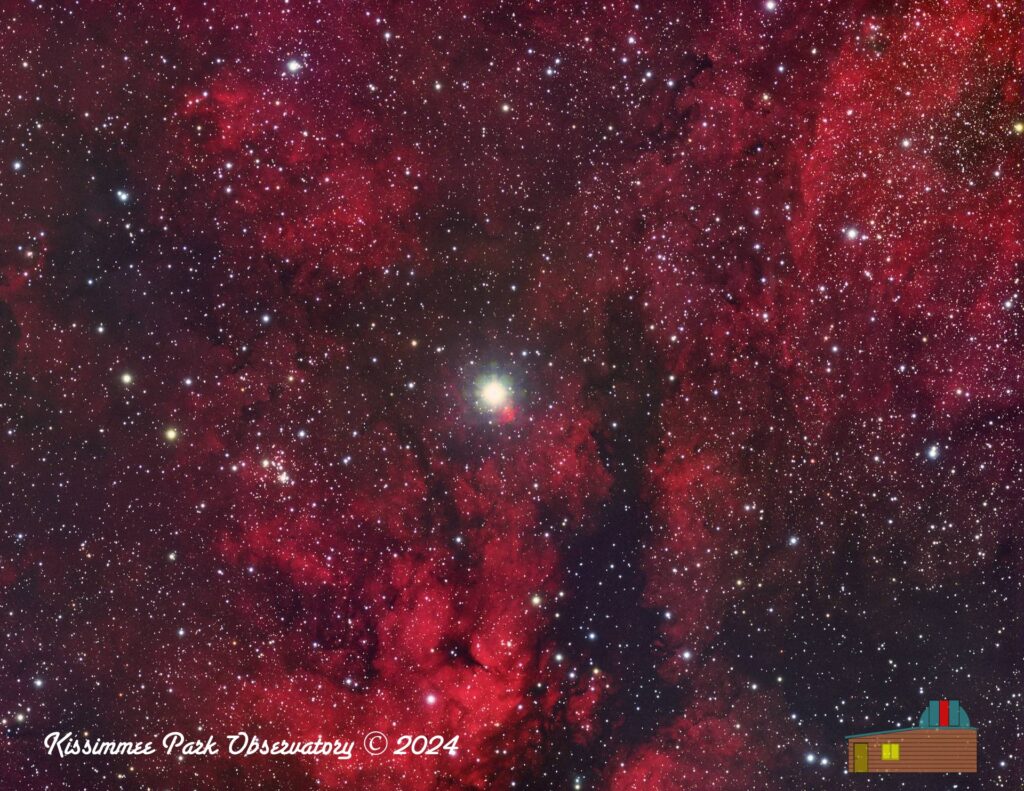
The Gamma Cygni Nebula, IC 1318, as captured by the Wide Field Astrographic Camera (WFAC) from near Murphy, North Carolina (Bortle 3). 3.7 hour integrated exposure.
The Mysterious Gamma Cygni Nebula: Unraveling the Secrets of IC 1318
Deep within the cosmos, there exists a celestial marvel that has captured the fascination of astronomers and astrophysicists alike. Known as IC 1318, or the Gamma Cygni Nebula, this interstellar wonder is an object of intense scrutiny for its extraordinary beauty and enigmatic nature.
Located approximately 3,000 light-years away in the constellation Cygnus, the Gamma Cygni Nebula is a prominent example of a diffuse nebula. This category of celestial bodies refers to vast clouds of ionized gas that have been expelled into space by high-mass stars during their final stages of evolution. Within these clouds, charged particles are energized by the radiation emitted from nearby stars, creating a breathtaking spectacle of swirling colors and intricate patterns.
The Gamma Cygni Nebula stands out among its peers for several reasons. Firstly, it is enormous – spanning approximately 80 light-years in diameter – making it one of the largest known nebulae in our Milky Way galaxy. Secondly, its vivid hues of reddish-purple are a result of the complex interplay between ionizing radiation from nearby stars and the varying densities and temperatures of the gas within the nebula.
But what truly sets IC 1318 apart is its striking resemblance to a large butterfly in flight, with sweeping wings stretching across vast distances of space. This unique shape has earned it the nickname “The Butterfly Nebula,” although it should be noted that this appellation is more poetic than scientifically accurate.
So, what can we learn from studying the Gamma Cygni Nebula? For one, it offers a rare glimpse into the life cycle of high-mass stars and their impact on the surrounding environment. By analyzing the chemical composition and physical properties of IC 1318, astronomers can gain valuable insights into the processes that shape our cosmos.
Moreover, the nebula serves as a reminder of the awe-inspiring beauty that lies hidden in the depths of space. As we continue to explore the mysteries of the universe, it is essential to appreciate and marvel at these celestial wonders that remind us of the boundless potential for discovery that awaits us.
In conclusion, IC 1318 – or the Gamma Cygni Nebula – is a testament to the majesty and complexity of our cosmos. Through further research and observation, we may yet uncover even more secrets hidden within this enigmatic celestial object, enriching our understanding of the universe and inspiring generations of scientists and stargazers alike.
Image Info
- Imaged from near Murphy, North Carolina (Bortle 3)
- Camera : ZWO ASI1600MM Pro
- Scope: Askar 400 Quintuplet Astrograph f/5.6
- Mount: iOptron Smart-EQ Pro
- Hydrogen Alpha: 23 subframes of 300s = 115 min integration
- Green: 11 subframes of 300s = 55 min integration
- Blue: 10 subframes of 300s = 50 min integration
- Total integration time: 220 min = 3.7 hours.
- Captured via ASIAir Pro automation
- Optical tracking via ASIAir automation via the ASI174mm Pro guide camera
- Separate channels stacked and HaGB integrated in Astro Pixel Processor
- Image run through Super DeNoising
- Final processing in Aperture
